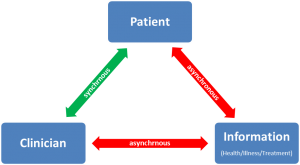One of the core drivers in healthcare industry is the information about health and disease. Clinicians are performing the task of eliciting information about illness from the patients, filtering out the noise from signals and producing actionable information, which leads to interventions. They are also burdened with the task of storing (documenting) and disseminating this information to patients and other relevant healthcare professionals. Some estimates put the time spent by a clinician in eliciting, documenting, storing and disseminating this information as up to 2/3 of their clinical time, with less than 20% actually spent in performing interventions (treatment). The role of information is so central in healthcare that it can be argued that its main business is the business of information. Therefore any factors which can alter the dynamics of information in our society are bound to affect healthcare business. Last two decades have witnessed many fundamental shifts in these dynamics.
If we look beyond the obvious proliferation of technology in the form of round the clock access to information from the internet from mobile computing devices or via online social networking, we would find that the way we consume information is undergoing a fundamental change. As a society, we are rapidly moving away from synchronous interpersonal communication (wherein both the originator and recipient of information have to be in same place at same time) as being our dominant form of communication. This shift towards asynchronous communication is not new, as it has been a part of human civilisation ever since we learned to draw in caves in ancient times. Asynchronous mode of communication became significant after the invention of paper and printing, but internet is giving it the impetus to become the dominant form of communication in human society. This also means that an ever larger amount of information is accessible by ever greater number of individuals.
In healthcare settings it means that the clinician no longer might be the primary information provider to a patient. Today both doctor and the patient have become voracious information consumers, using easily accessible knowledge to inform our decisions in millions of different ways. This shift is gradually changing the public perceptions of healthcare professionals, who are now less valued for their knowledge but more for their skills and experience. With easy access to detailed information, a tech-literate patient could possess more information about his illness than the doctor who had to study several thousand illnesses. However despite that our healthcare IT systems are usually designed to suit 20th century practices i.e. one to one synchronous interactions between the doctors and patients. This approach fails to capitalise on possible advantages offered by the asynchronous communication which has the potential to dramatically increase the reach of individual clinicians. But most importantly it fails to correct one of the most important drawback of the dominance of asynchronous communication, i.e. it is more error prone than the synchronous modes of communications. This is because unlike synchronous means of communications, which has spontaneous feedback loops (doubts can be immediately clarified by interacting parties in real time), feedback loops have to be created in asynchronous information ecosystems.
As an industry we have made little progress in this area, and still treat to keep most of the patient information as the proprietary information of the organisations. By evolving future healthcare systems in the direction of the shift in the flow of health information, the industry can potentially boost the productivity of individual clinicians. Rather than limited by traditional physical case load limits of a few hundred patients, a future clinician can practice on an unprecedented scale when aided by the right technology and policies.1The content of this post was later included in a chapter in the following publication: Tyagi, H. (2013). Health data technologies: the current challenges. In NEXUS STRATEGIC PARTNERSHIPS (Ed.), Commonwealth Health Partnerships. London: Nexus Strategic Partnerships for the Commonwealth Secretariat.
Also published on Medium.
footnotes
| ↑1 | The content of this post was later included in a chapter in the following publication: Tyagi, H. (2013). Health data technologies: the current challenges. In NEXUS STRATEGIC PARTNERSHIPS (Ed.), Commonwealth Health Partnerships. London: Nexus Strategic Partnerships for the Commonwealth Secretariat. |
|---|

Pingback: Digital Psychiatry: will advancing technology support or destroy the patient-professional relationship? | Himanshu Tyagi